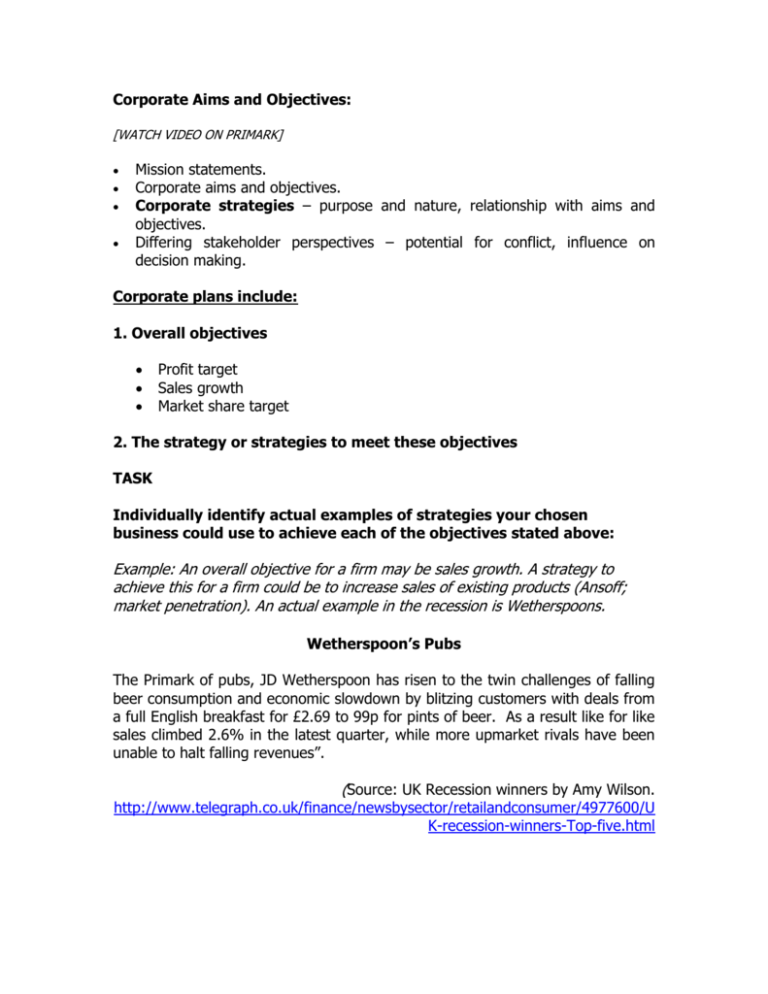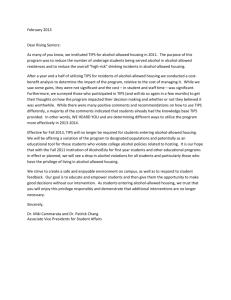Corporate Aims and Objectives:
advertisement

Corporate Aims and Objectives: [WATCH VIDEO ON PRIMARK] Mission statements. Corporate aims and objectives. Corporate strategies – purpose and nature, relationship with aims and objectives. Differing stakeholder perspectives – potential for conflict, influence on decision making. Corporate plans include: 1. Overall objectives Profit target Sales growth Market share target 2. The strategy or strategies to meet these objectives TASK Individually identify actual examples of strategies your chosen business could use to achieve each of the objectives stated above: Example: An overall objective for a firm may be sales growth. A strategy to achieve this for a firm could be to increase sales of existing products (Ansoff; market penetration). An actual example in the recession is Wetherspoons. Wetherspoon’s Pubs The Primark of pubs, JD Wetherspoon has risen to the twin challenges of falling beer consumption and economic slowdown by blitzing customers with deals from a full English breakfast for £2.69 to 99p for pints of beer. As a result like for like sales climbed 2.6% in the latest quarter, while more upmarket rivals have been unable to halt falling revenues”. (Source: UK Recession winners by Amy Wilson. http://www.telegraph.co.uk/finance/newsbysector/retailandconsumer/4977600/U K-recession-winners-Top-five.html 3. The main objectives for the key departments of the business derived from the overall objectives. TASK Identify the main internal and external influences on a corporate plan Internal External The value of corporate plans Corporate planning is not just for the benefit of senior management, it is paramount that the information is shared with everyone within the organisation. Key stakeholders it should be shared with are: Potential investors (share issue) Major lenders (Banks/Financial institutions) Government All staff (SMART targets for departments) TASK Explain why it is important that the plans are shared with each of the above stakeholders. Mission and Objectives Businesses strengths must fit in with both the mission statement and corporate objectives of the organisation. However, it could be argued that in a crisis situation of a recession it might be necessary to jettison existing mission and objectives, it should only be done after careful consideration. For instance, the obvious strategy of going downmarket as a discount retailer might at first be appealing, but such a change might undermine the organisation’s mission of seeking to be the “first choice source of quality products.” Contradictory signals about price and quality will confuse consumers and might lead to further lost sales from otherwise loyal customers. Contingency Planning Business success is always based on a sound plan which identifies where the company is going and how it intends to get there. But, alongside the normal business plan some consideration should be given to the “what if questions” eg what will happen if the economy is plunged into recession? And contingency plans should be drawn up based on worst case scenarios. Final Tips for Business Survival “It is a sad fact of business life that some businesses will fail… But with the acumen, finance and the drive to succeed, following some basic rules may dramatically improve a company’s chances of success.” (David Robertson, CEO of Bibby Financial Services). His top ten tips are: David Robertson, CEO of Bibby Financial Services’ Top Ten Tips for Survival 1. Plan – research the market, construct and be prepared to revise your business plan as circumstances change. 2. Pace yourself – investing too much too soon may lead to a business becoming over-stretched. 3. Credit – negotiate longer credit terms with your suppliers, but set shorter terms for your customers. 4. Layout your terms – establish and agree credit terms upfront. Ensure invoices are issued promptly, clearly displaying the conditions of the transaction. 5. Recognise that “cash is king” – it is no good generating high sales volume if it is not quickly followed by inflow of cash. 6. Streamline – look to ways in which internal processes can be carried out more efficiently. Cut out waste. 7. Delegate – to free up the time of top management to focus on core activities and strategic decisions. 8. Ask the experts – seek external advice where necessary. 9. Be honest and realistic. If things are not working out how you thought they would, address the reasons why this is happening and find a new approach. 10. Roll with the punches – be decisive in tackling any problems head on and deal with them promptly. Source: adapted from Top Ten Tips for Business Survival – www.smallbusinesses.co.uk SWOT Analysis for BSAK – use sheet on Weebly.











